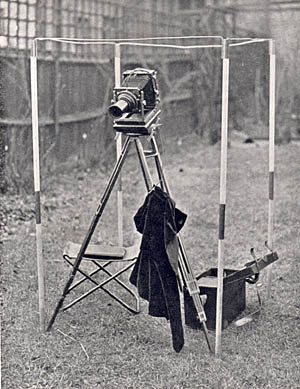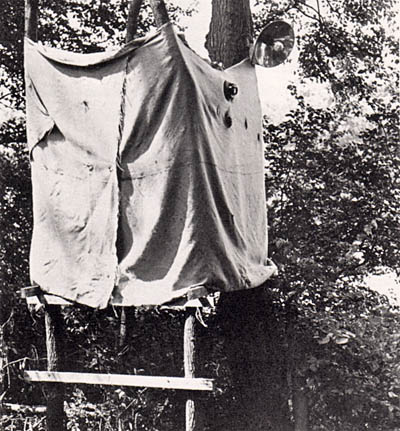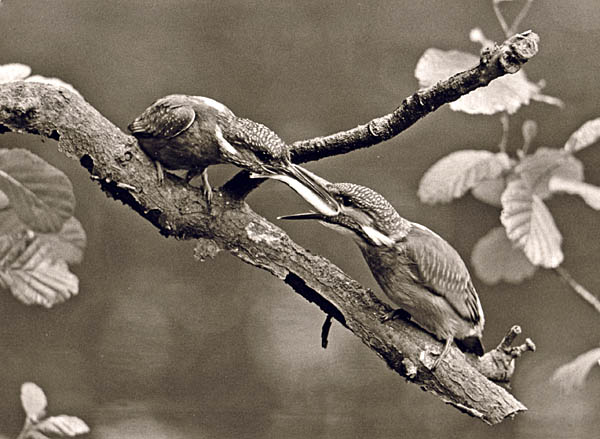|
A
Small Synopsis of Time
Almost
unheard of: General photography is in part a child of wildlife/nature
photography, or better yet: The driving force for the discovery
of photography came from the desire of one of the founding
fathers of this medium to take wildlife/nature pictures.
William
Henry Fox Talbot wanted to keep more accurate and exact
impressions of his travels then was possible with his drawings.
That is why he was looking for a type of fixing agent in order
to make the blackened silver-nitrate within the Camera Obscura
more resistant to light. He started his experiments in 1834 and
was able to take first photos in August of 1835.
Wildlife/Nature
photography started towards the end of the 19th
century. Ottmar Anschütz (1846-1907) made his famous photo
series of storks in 1884 and R.B. Lodge took the first outdoor
pictures of a brooding peewit in 1895.
Outdoor
wildlife photography became possible when the collodion process
was replaced in 1880 by the factory made dry gel on paper plate.
This plate was twenty times as sensitive to light and 4 years
after its introduction Anschütz took his sensational pictures
of storks. The Zoological Society of London organized an
exposition as early as 1912 in which already 174 types of birds,
95% of which were taken outdoors in nature, were displayed.
Richard
Kearton
One
of the first nature and bird photographers was Richard Kearton.
He was born on
January 2, 1862
in a small
village called Swaledale
England
, where his
ancestors had lived as farmers since 1350.
In
the fall of 1882, when Kearton was going on 21, Sidney Golpin
visited this place called Swaledale to hunt ducks. Kearton
showed him the moor with all its fascinating natural beauty and
this impressed Golpin in such a way that he invited Kearton to
London
and gave him a
job in his publishing house.
Kearton
started to write articles on nature and soon he wanted to
illustrate these articles with his own photos of animals living
free in nature. Richard Kearton “invented” the camouflage
tent which in a more progressive way is still used by bird
photographers today. He discovered that birds are oblivious of
other animals such as cows, horses or sheep. That is why his
first camouflage tent resembled a cow. Later on his camouflage
tent became more and more abstract until finally the idea itself
became to be a universal fact in the guild of bird photography:
that camouflage tents could look like anything except for
“Gods greatest creation”. The free-living birds seemed and
still seem to hold it in very low regard.
Kearton,
together with his brother Cherry, traveled all over
Great Britain
as far as St.
Kilda. His adventures on the group of islands off the coast of
Scotland
were described
by him in probably the best book about St. Kilda “With Nature
and a Camera”.
Kearton
published many photographs, books and held numerous lectures.
When he died on
February 8, 1928
he was
considered the classic senior champion in the art of wildlife/nature
photography.
|

This
is what the standard equipment of bird photographers looked like
before it changed to the small format SLR: a 9x12 plate camera
with a swiveling back, so that you could put the main focus on
the front edge of the nest and on the parent bird that is either
sitting and/or feeding at an angle to the nest.
|
Eric
Hosking
Eric
Hosking was born in 1909. When he was a student he already
answered the typical questions from his dear aunts about what it
was that he wanted to be when he grew up, in contradiction to
the standard answer of “train engineer”, with a firm and
distinct:”bird photographer”.
This
answer had a small flaw to it: there was no profession called:
bird photographer. No one had ever specialized in and
concentrated their effort as consistently on bird photography as
he did. Today many live FOR bird photography but no one besides
Hoskins has ever been able to live FROM it.
Eric
Hoskins has published innumerable pictures of birds, he has
written many books about birds and bird photography and released
his autobiography, “An Eye For a Bird” in 1970 with a
preface written by Prince Philip, Duke of Edinburgh. A clear
sign of position and high standing enjoyed by a bird
photographer like Eric Hosking in
Great Britain
: Just imagine
the biography of Hermann Fischer published here in
Germany
with a preface
by President Horst Köhler. Imaginable? Would someone buy the
book? Hoskings autobiography had multiple editions and even a
paperback concession. Hoskings break-through as a bird
photographer came in 1937, when he was attacked by a tawny owl
in Whales and lost an eye. The media reported it everywhere and
Hoskings was suddenly famous in all of
Great Britain
. Since that time
all bird photographers who take owl pictures on that island wear
masks just like in fencing.

|
Barn
owl with a captured rat.
Photo:
Eric Hosking (1936)
Sanderson
Field Camera, 21 cm Dallmeyer-Lens, Aperture of 16,
flash bulb.
Taken
from out of a tent on a raised stand that Eric Hoskings
built on a pedestal in front of a tree (see the picture
below).
Back
at that time there was no link which synchronized the
shutter speed with the flash. That meant that Eric
Hoskings had to wait in utter darkness until he heard a
scratching noise on the tree trunk signaling that a barn
owl had landed. He then opened the shutter speed of the
camera, sparked the flash and then closed the shutter
speed of the camera again.
These
flash bulbs only flashed once and then the bulb was
burned out and Eric Hosking had put his hand out of the
camouflage tent, screw the flash bulb (careful! hot!)
out of the socket and still in complete darkness,
replace it with a new one for the next approach of the
owl. He was not using sheet film at that time, but glass
plates as a base material for the emulsion of B/W.
When
I saw this picture by Eric Hosking for the first time, I
was enrapt and it is still my all time favorite picture
from the early times of wildlife/nature photography.
Eric Hosking had no idea how photogenic the animals pose
was, he didn’t see that until after developing.

|
Hermann
Fischer
Hermann
Fischer was born
November 2, 1885
. All of his life
he photographed wildlife – painstakingly and with great
success. He died in 1975, shortly before his 90th
birthday, in Braunschweig. He was the role model of an entire
generation of post-war wildlife photographers in
Germany
.
The
1953 edition of his book “Tierjagd mit der Kamera (Hunting
Animals With a Camera)” became the bible for wildlife/nature
photographers of his period.
Hermann
Fischer started out as a painter before WWI and was to be
accepted in the
School
of
Arts
in
Weimar
through a
scholarship from the city of
Braunschweig
. The First World
War wanted something different. H. Fischer returned to
Braunschweig puzzled and worked for the car maker Büssing. He
became self-employed in 1923 as a wildlife/nature photographer.
He may have possibly been the first German to put into effect
what many nature-loving junior wildlife/nature photographers try
nowadays: to live and work as freelancers.
He
illustrated the books by Hermann Löns and Meerwarth and his
pictures were such a sensational success that we can hardly
imagine it in these jaded times. His main area of operation was
the Lüneburger Heide (the heath by Lüneburg) where he
documented landscapes, people and animals. His work shaped an
entire era.
Walter
Wissenbach
Walter
Wissenbach, born in 1901, was the first master of photography of
a new generation of wildlife/nature photographers following
Hermann Fischer. He brought the technique of quick flash
photography in connection to the photo sensor developed by Eric
Hosking in
England
during the
Second World War to
Germany
and he was also
the first to have tremendous success with it in
Germany
in the fifties.
Pictures
of flying birds, very sharp and of incredible richness in detail
had not been seen until then. Even large weekly newspapers like
the “Frankfurter Illustrierte (Frankfurt Illustrated)” at
that time very often printed reports of Wissenbach´s work on a
several page spread. Whereas
Hermann Fischer lived as an all-round wildlife/nature
photographer, Walter Wissenbach, 16 years younger, was purely a
bird photographer. He
won
many
awards with his pictures, starting with the Leica Photo Contest
all the way to the Senckenberg Medal.
During
the last 15 years before his death fewer and fewer pictures by
him were seen due to his health.
Whereas
senior master photographer Hermann Fischer represented the
pioneering generation during the post-war years, Walter
Wissenbach was at the peak of bird photography, all by himself,
during the 50s and up into the 70s in
Germany
.

|
One
of my “earlier” (1954) remote controls before there were modernized
electric wireless remote control releases. I cut an opening into
the center of a roll of toilette paper and on it there was a
250-gram weight above a match. If I pulled on the string at a
distance of 100 m, the match would be pulled out, the weight
fell onto a wire trigger, pushed it in and set off the shutter
of the Agfa Box 6x9 right next to it.
You put flash powder into the pan on top of the box.
Actually, I should have gotten a Nobel Prize for this
ingenious construction.
|

|
Kingfisher
is feeding his fledgling
Photo:
Fritz Pölking
Eltings
Mühlenbach in the Hüttruper Heide (Hüttrup Heath) close to
Greven (1975).
Olympus OM-1, 2.8/135 mm, Agfapan-400, tripod,
camouflage tent.
Small
format cameras, lenses and even film material were improving
constantly while the great era of black and white photography
was coming to a definite end. The first motorized winders were
already available.
|
Some
important Stages
1955 is when modern times began as far as equipment in wildlife/nature
photography was concerned, the Noflexar 5.6/400 mm, which
represented the highest standard until later on the lenses with
internal focus (AF) and TTL (through the lens metering) came
onto the market.
1960-1980
The first zoom lenses slow and not very good, were already
available in 1960. This changed, became much better with
improved light conditions in the 80s and the wildlife / nature
photographers started to become more acquainted with it.
1980 the first photo back packs (or rucksacks) that made our lives much
easier were available.
1980 we were also introduced to the first split filters with which we
finally were able to bridge the contrast of the dark Tundra in
the foreground and the snowy mountains in the background.
1985 we got the AF (auto focus) in the SLR (Single Lens Reflex) cameras and
Minolta was the first company that brought a 2.8/300 mm and
4.0/600 mm lens with the AF onto the market.
1985 the DX (Digital Index) encoding came and we stopped exposing the 200
Kodachrome, i.e. 25 ISO.
1990 is when Adobe-Photoshop 1.0 came, but no wildlife/nature photographer
took any notice at all of it.
1991 the first digital SLR from Kodak with 1.3 mega pixels was available
for Photojournalists.
1993 the first Coolscan from Nikon, the most common used slide scanner
among wildlife/nature photographers was available, today it is
called Nikon Super Coolscan 5000 ED.
1994 the first tripods made of carbon fiber that make life easier for us
and keeps frostbite from our hands came out.
1995 we got the first lens with a stabilizer, the 4-5.6/75-300 mm Canon EF
2004 was the time the first professional digital Canon-SLR for wildlife/nature
photographers came out, the EOS 1 D Mark II
2005, the year of the first professional digital Nikon-SLR for wildlife/nature
photographers, the D2x.
|